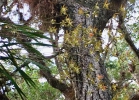|
|
|
|
 |
Email Address Recovery or Password Reset |
Use our Change Password page, and you can set a new password, or if you don't remember which email address you
registered with, the same page may be able to suggest it based on another you enter.
|
|
|
|
|
| |
Flasks of
Encyclia tampensis '19-112-5' -spontaneous |
|
| |
|
|
| |
| Number: |
TN8954 |
| Name: |
Encyclia tampensis '19-112-5' -spontaneous
|
| Type: |
spontaneous (What's that?) |
|
Seed Donor: |
Jim Hanlon
|
|
Click to Enlarge

Pod Parent Inflorescences |
|
|
|
| |
For additional origin/habitat information supplied courtesy of
Charles and Margaret Baker, see further below, near the bottom of this page.
|
Temperatures we attempt to use in the lab & greenhouse:
| For Species: |
|
Spring, Summer, Autumn: days average 90°F, nights 73°F; best fit is Warm 90-70°F
(Source:
Baker's Web OSC) |
| For Species: |
|
Winter: days average 71°F, nights 53°F; best fit is Cool 70-52°F
(Source:
Baker's Web OSC) |
|
About the name...
| Etymology of |
Encyclia |
|
From Greek "enkyklein" to surround, in reference to the lip enclosing the column.
(Source:
Pridgeon 1992) |
| Etymology of |
tampensis |
|
Means "from Tampa" (Florida, USA)
(Source:
Troy Meyers) |
| Pronunciation of |
Encyclia |
|
en-SIK-lee-ah
(Source:
Pridgeon 1992) |
| Pronunciation of |
tampensis |
|
tam-PEN-sis
(Source:
Hawkes 1978) |
|
If you would like to direct someone to this web page, please copy and paste this URL into your email:
http://troymeyers.com/d?018954
| Flask Information |
| Availability: |
We have approximately 150 plants in intermediate-stage flasks, but this may not be enough to make flasks for new requests, because we are still making flasks for prior requests. |
| You should: |
Reserve a flask now. Even though we might not have enough plants, if someone drops out ahead of you you many get a flask. If you wait, this will be less likely because you would be further down on the list. |
| Yield Estimate: |
338 plants (based on flask surveys done 03/21/2022 through 05/31/2023)
|
| Plantlet Sizes: |
From many flasks 20 - 80 mm plants (based on flask surveys done 03/21/2022 through 05/17/2023)
From one most recently surveyed flask 30 - 80 mm (05/17/2023)
|
| Expected Flask Price: |
$40.00 per flask of 25 (min.) plants
|
|
You might also want to:
|
View the seed assay for this item.
See if we have plants available in the greenhouse.
View items of the same species.
View items of the same genus.
|
| Ordering Information |
| You are not currently logged in. |
|
You must be a registered user and be logged in to reserve a flask or place a notification request. Please log in:
|
|
 |
Email Address Recovery or Password Reset |
Use our Change Password page, and you can set a new password, or if you don't remember which email address you
registered with, the same page may be able to suggest it based on another you enter.
|
|
|
|
|
|
|
|
| |
The origin/habitat information below is supplied courtesy of Charles and Margaret Baker
The following information is based on the name of the plant provided by the donor, and assumes that the name is correct. If the plant has been misidentified, then the following information may not be correct.
This text is copyrighted by the Bakers and may not be reproduced without permission.
ORIGIN/HABITAT: The Bahama Islands and Florida. This orchid was first
collected near Tampa, Florida in 1846 and is the most common epiphytic
orchid in Florida. Plants grow at low elevations in conditions that vary
from dark, humid, swampy forests to high (relatively), dry, barren trees
in full sun, and Luer (1972) reported that plants survive a hard freeze.
Plants have been found growing on palm trees and on fence posts. In the
Bahamas, plants grow in coppices on Grand Bahama Island and on Andros
Island.
More about this information and the Bakers...
|
|
|
| |
|
|
|